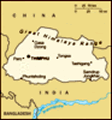Bhutanese Economy, Bhutan Economy
Advertisement
Economy - overview: The economy, one of the world's smallest and least developed, is based on agriculture and forestry, which provide the main livelihood for more than 90% of the population. Agriculture consists largely of subsistence farming and animal husbandry. Rugged mountains dominate the terrain and make the building of roads and other infrastructure difficult and expensive. The economy is closely aligned with India's through strong trade and monetary links and dependence on India's financial assistance. The industrial sector is technologically backward, with most production of the cottage industry type. Most development projects, such as road construction, rely on Indian migrant labor. Bhutan's hydropower potential and its attraction for tourists are key resources. Model education, social, and environment programs are underway with support from multilateral development organizations. Each economic program takes into account the government's desire to protect the country's environment and cultural traditions. For example, the government, in its cautious expansion of the tourist sector, encourages visits by upscale, environmentally conscientious tourists. Detailed controls and uncertain policies in areas like industrial licensing, trade, labor, and finance continue to hamper foreign investment.
GDP: 1.8% (2004)
GDP - real growth rate: 5.3% (2003 est.)
GDP - per capita: Purchasing power parity - $1,400 (2003 est.)
GDP - composition by sector: Agriculture: 45% industry: 10% services: 45% (2002 est.)
Population below poverty line: NA
Household income or consumption by percentage share: Lowest 10%: NA highest 10%: NA
Distribution of family income - Gini index:
Inflation rate (consumer prices):
Labor force: NA note: massive lack of skilled labor
Labor force - by occupation: Agriculture 93%, industry and commerce 2%, services 5%
Unemployment rate: NA
Budget: Revenues: $146 million expenditures: $152 million, including capital expenditures of NA note: the government of India finances nearly three-fifths of Bhutan's budget expenditures (FY95/96 est.)
Industries: Cement, wood products, processed fruits, alcoholic beverages, calcium carbide
Industrial production growth rate: 9.3% (1996 est.)
Electricity - production: 2.001 billion kWh (2002)
Electricity - production by source:
Electricity - consumption: 312.9 million kWh (2002)
Electricity - exports: 1.56 billion kWh (2002)
Electricity - imports: 12 million kWh (2002)
Oil - production: 0 bbl/day (2001 est.)
Oil - consumption: 1,020 bbl/day (2001 est.)
Oil - exports: NA
Oil - imports: NA
Oil - proved reserves:
Natural gas - production:
Natural gas - consumption:
Natural gas - exports:
Natural gas - imports:
Natural gas - proved reserves:
Agriculture - products: Rice, corn, root crops, citrus, foodgrains; dairy products, eggs
Exports: $154 million f.o.b. (2000 est.)
Exports - commodities: Electricity (to India), cardamom, gypsum, timber, handicrafts, cement, fruit, precious stones, spices
Exports - partners: Bangladesh 47.4%, Japan 30.2%, France 3.4% (2004)
Imports: $196 million c.i.f. (2000 est.)
Imports - commodities: Fuel and lubricants, grain, machinery and parts, vehicles, fabrics, rice
Imports - partners: Germany 65.4%, Japan 14.3%, Austria 6.8%, UK 4.5% (2004)
Debt - external: $245 million (2000)
Economic aid - recipient: Substantial aid from India and other nations
Currency:
Currency code:
Exchange rates: Ngultrum per US dollar - 45.317 (2004), 46.583 (2003), 48.61 (2002), 47.186 (2001), 44.942 (2000)
Fiscal year: 1 July - 30 June
Advertisement
The information here has been derived from Public Domain Sources such as the CIA World Factbook. No liability can be taken for any inaccuracies.
Tot: 0.048s; Tpl: 0.008s; cc: 5; qc: 8; dbt: 0.016s; 1; m:domysql w:travelblog (10.17.0.13); sld: 1;
; mem: 1.1mb

 In 1865, Britain and Bhutan signed the Treaty of Sinchulu, under which Bhutan would receive an annual subsidy in exchange for ceding some border land. Under British influence, a monarchy was set up in 1907; three years later, a treaty was signed wher...
In 1865, Britain and Bhutan signed the Treaty of Sinchulu, under which Bhutan would receive an annual subsidy in exchange for ceding some border land. Under British influence, a monarchy was set up in 1907; three years later, a treaty was signed wher...
